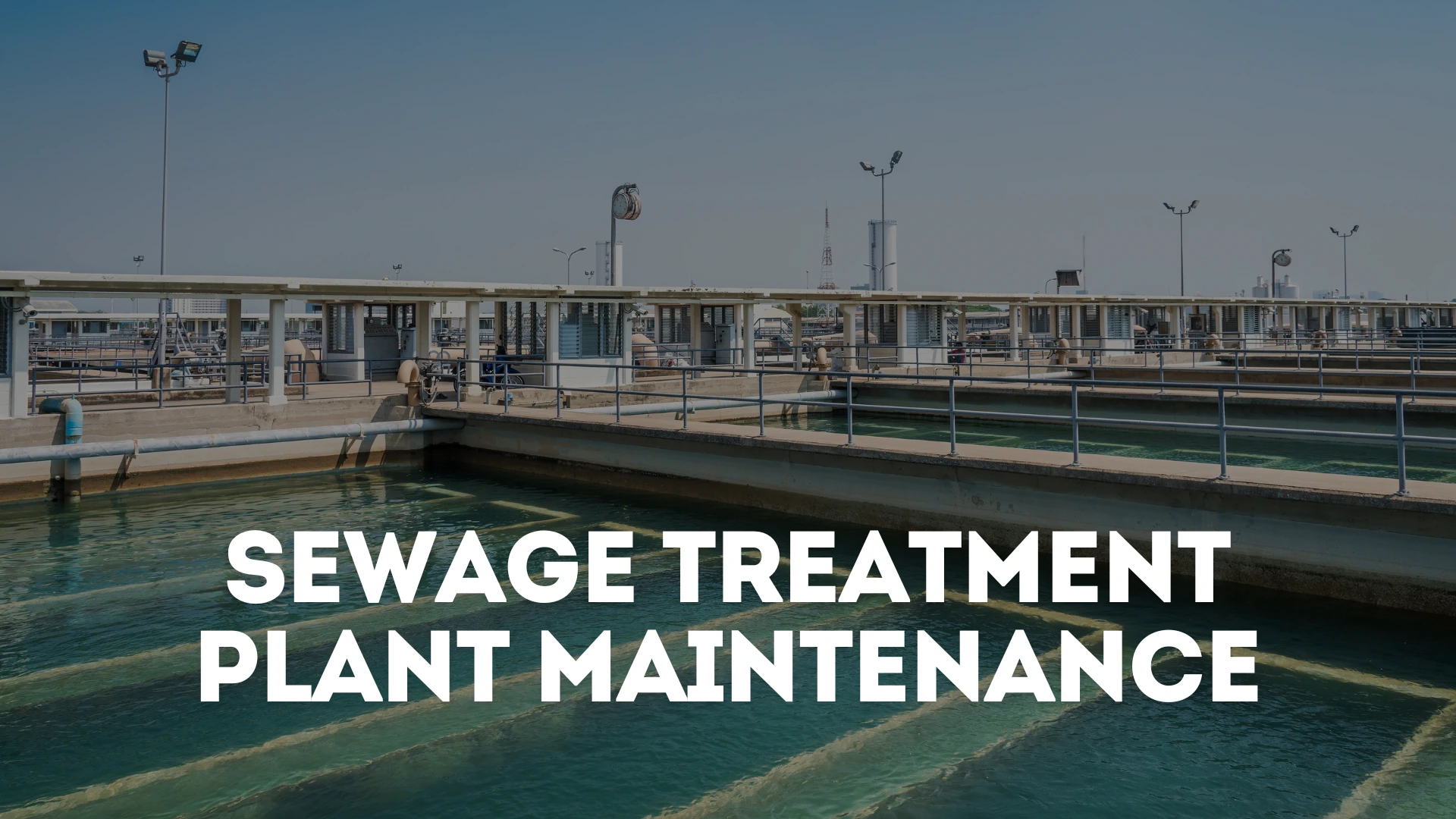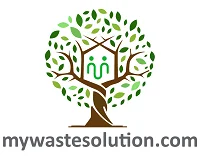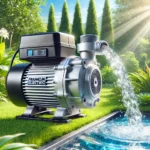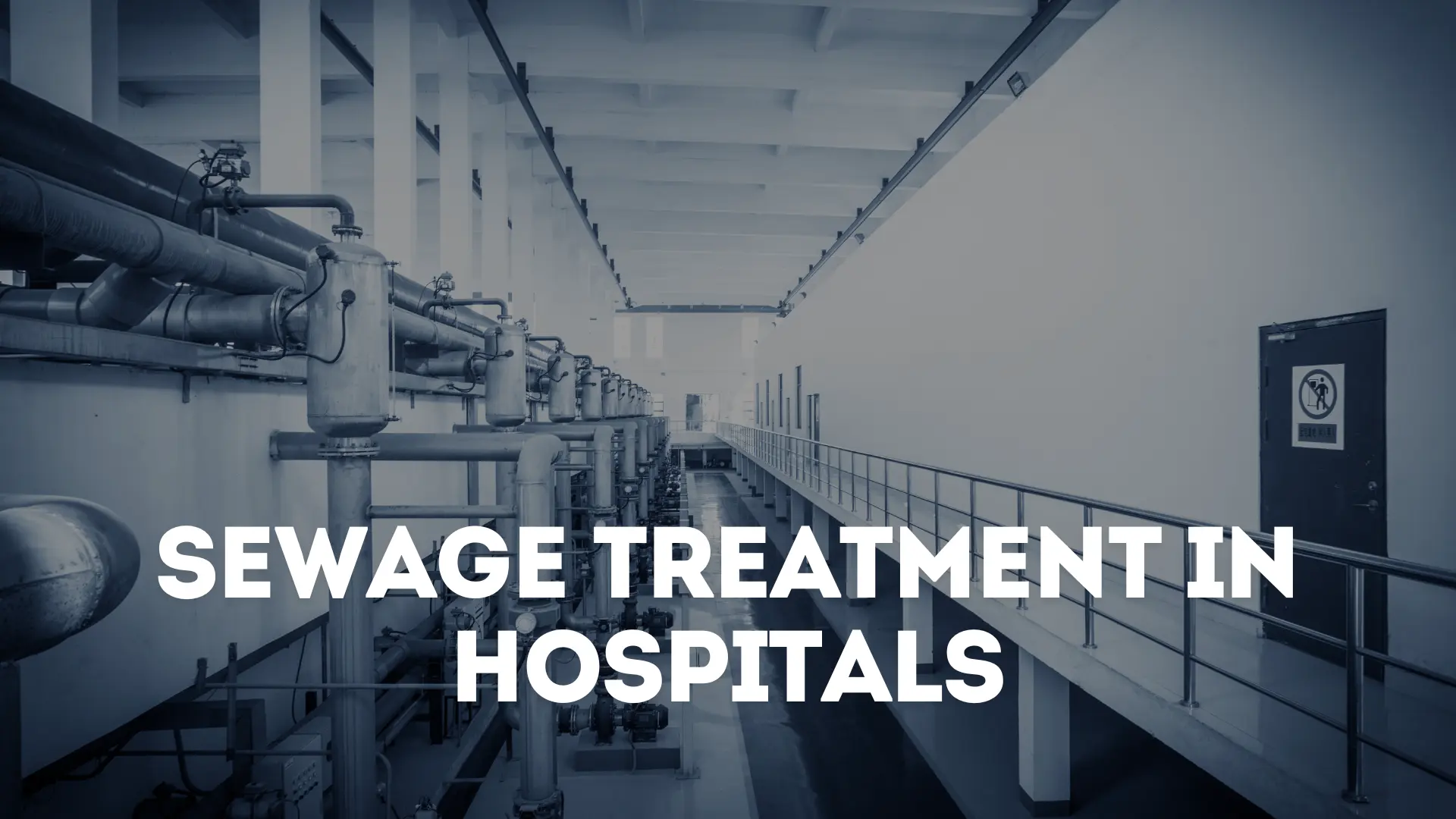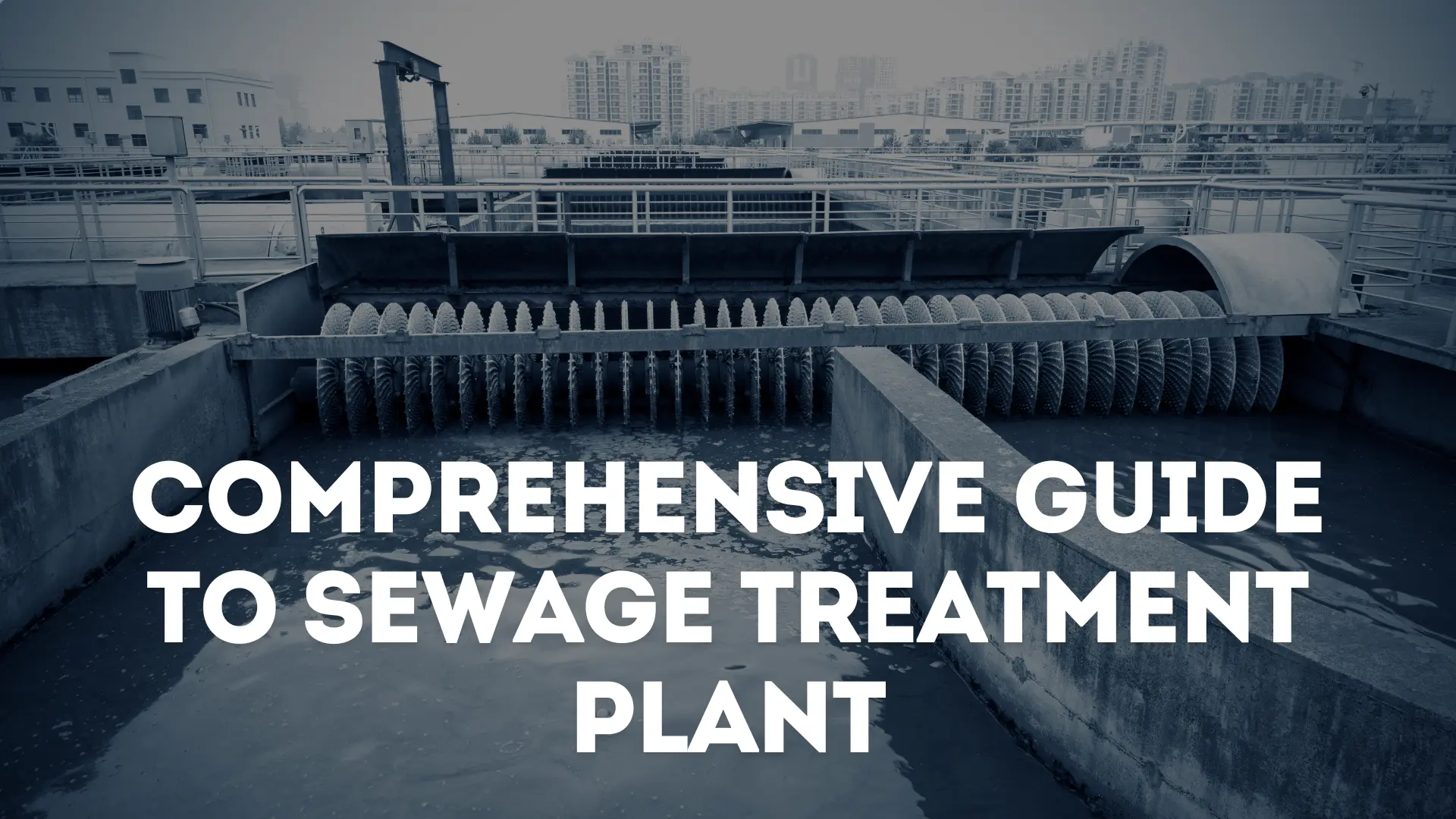1. Introduction
Ever wondered where your wastewater goes? It comprises a blend of used water, human waste, household chemicals, and more from residences, businesses, and industries. This combination of liquid and solid waste demands effective processing to safeguard the environment. Sewage Treatment Plant Maintenance play a crucial role in managing this waste through initial, primary, secondary, and tertiary purification stages.
Why is this important? Proper wastewater treatment is key to preventing environmental pollution, protecting public health, and conserving water resources. Routine maintenance and adherence to environmental regulations are essential for STP to function optimally and address complex waste management challenges.
Here’s to the Maintenance of Sewage Treatment Plant and the dedicated teams ensuring our water stays clean and safe!
1.1 Understanding Sewage Treatment Plant Maintenance
Sewage Treatment Plant Maintenance addresses environmental pollution and public health risks from uncontrolled wastewater. Traditional methods like irrigation and filtration became inadequate. In addition, growing populations strained natural water systems. To address these issues, modern sewage treatment plants (STPs) were developed to efficiently enhance natural processes.
Sewage Treatment Plants are crucial to urban infrastructure, utilizing physical, chemical, and biological methods in order to adhere to strict regulatory standards. Moreover, one byproduct, sewage sludge, requires further processing before disposal. The entire process begins with debris removal, then moves to primary processing (solid settling), secondary processing (microorganisms breaking down pollutants) occurs, and tertiary processing (filtration and disinfection) is completed. Effective sludge management ensures environmentally friendly disposal.
The efficiency of STPs relies on the coordination and upkeep of pumps, motors, and filters. These integrated systems aid in water conservation, while also supporting environmental regulations and contributing to public health protection and sustainability.
1.2 Why Sewage Treatment Plant Maintenance Matters?
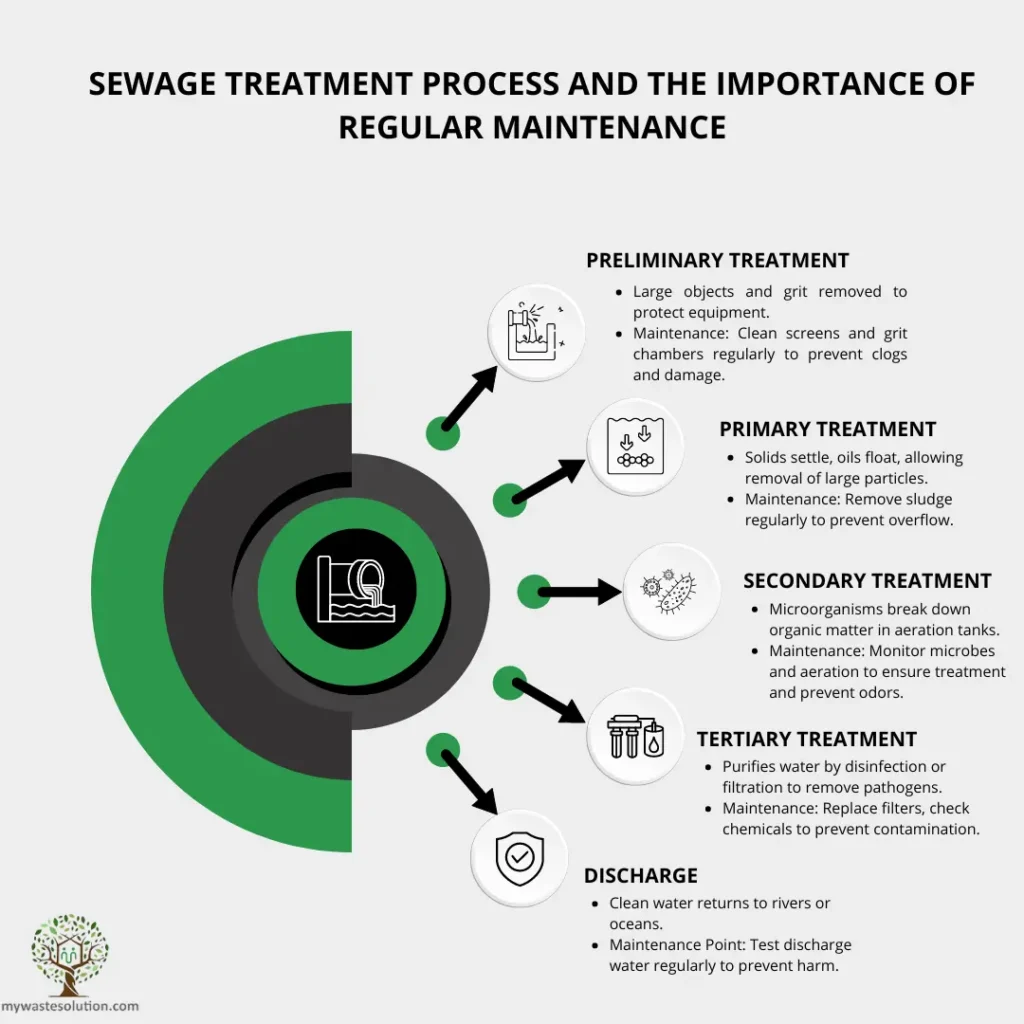
Sewage Treatment Plant Maintenance is essential for environmental protection and public health. Regular maintenance ensures smooth operations and prevents breakdowns, keeping these crucial systems efficient and reliable.
- Prevents Breakdowns: Routine inspections identify potential issues early, avoiding costly system failures and ensuring continuous operation.
- Optimizes Efficiency: Well-maintained components like pumps, motors, and filters boost overall system efficiency, improving the sewage treatment plant maintenance process.
- Extends Lifespan: Timely repairs and lubrication extend the life of equipment, minimizing expensive replacements.
- Ensures Compliance: Regular upkeep helps meet environmental regulations, avoiding legal complications and protecting the environment.
- Enhances Safety: Addressing hazards proactively ensures a safer work environment for personnel.
- Reduces Costs: Though maintenance requires investment, it reduces emergency repairs and lowers long-term operational costs.
Regular maintenance is critical for keeping sewage treatment plants efficient, safe, and compliant. It’s a proactive approach that upholds sustainability, environmental responsibility, and reliable wastewater management.
Explore Wastewater Treatment Solutions
Find top machinery, plants, tools, resources, companies, and consultancy for comprehensive sewage treatment plant maintenance solutions.
2. Essential Components of Sewage Treatment Plant
Ever wondered about the unseen infrastructure that tirelessly transforms our everyday wastewater into something safe and eco-friendly? Welcome to the world of Sewage Treatment Plants—essential establishments that ensure our water is properly processed before it reenters the environment. These facilities operate with a precise mix of technologies and methods, all functioning together behind the scenes. Let’s take a behind-the-scenes tour and explore the key components that keep these crucial operations running smoothly.

2.1 Major Components of Sewage Treatment Plant
| COMPONENTS | PURPOSE | PARTS |
| Inlet Works | Initial point where sewage enters the treatment process. | Screens to remove large debris, grit chambers for sand and grit removal. |
| Primary Treatment Units | Settling tanks where solid particles settle, forming sludge | Primary clarifiers or sedimentation tanks. |
| Aeration Tanks (Secondary Treatment) | Biological treatment to break down organic pollutants. | Aeration systems, diffusers, and microbial cultures. |
| Secondary Clarifiers | Separation of biological sludge from treated water. | Clarifiers or settling tanks for further solid-liquid separation. |
| Filtration Units (Tertiary Treatment): | Additional removal of fine particles and impurities. | Sand filters, microfiltration, or other advanced filtration methods. |
| Disinfection Systems | Elimination of harmful microorganisms. | Chlorination, UV irradiation, or other disinfection technologies. |
| Sludge Treatment Facilities | Processing and handling of sludge produced during treatment. | Sludge digesters, dewatering equipment, and disposal methods. |
| Effluent Outflow: | Safe discharge of treated water into the environment | Outfall pipes or channels. |
| Control and Monitoring Systems: | Oversight and regulation of treatment processes. | Sensors, monitoring equipment, and control panels |
| Odour Control Units: | Minimizing unpleasant odors associated with wastewater treatment. | Chemical scrubbers, biofilters, or other odor control methods. |
These key components collaborate to ensure effective wastewater processing, removing impurities and contaminants before releasing treated water back into natural water sources. Each element is vital for maintaining the facility’s performance, ensuring that each phase contributes to superior, eco-conscious results.
2.2 Maintenance Needs for Key Components
The smooth operation of a wastewater facility relies on advanced technology, proper funding, and a robust governance framework. At Sewage Treatment Plant Maintenance, we prioritize routine upkeep—inspections, lubrication, electrical checks, and timely repairs. Ongoing care prevents breakdowns, reduces wear and tear, and ensures that key components like pumps, motors, pipes, and filters operate optimally, thereby extending their lifespan and enhancing overall performance.
In this section, we’ll explore essential maintenance practices to keep sewage treatment systems operating at peak efficiency.
A. Pumps and Motors
- Function: Pumps transfer water through various processing stages, while motors provide the necessary power.
- Maintenance Needs: Routine lubrication, alignment checks, and wear assessments are essential. Regular inspections prevent system failures and ensure smooth operation.
B. Pipes and Conduits
- Function: Pipes form the network that moves water between different processing phases.
- Maintenance Needs: Regular inspections for leaks, corrosion, and blockages are crucial. Timely repairs or replacements prevent disruptions and maintain consistent water flow.
C. Filters and Processing Units
- Function: Filters and units remove impurities and contaminants from water.
- Maintenance Needs: Regular cleaning or filter replacement, inspections for wear, and monitoring of chemical dosing systems are essential for peak functionality.
Proactive and consistent plant maintenance is essential for extending equipment life. This approach ensures the facility operates efficiently, processes water effectively, and complies with environmental standards.
Struggling with sewage treatment plant maintenance? Connect with top consultants specializing in sewage treatment plant solutions.
Connect Now3. Top Challenges and Solutions in Sewage Treatment Plant Maintenance
In wastewater treatment facility operations, addressing common problems is crucial for maintaining smooth functionality. This guide outlines three frequent challenges: clogging and blockages, equipment degradation, and chemical imbalances.
Importance of Proactive Management:
By proactively managing these concerns, wastewater treatment plants can ensure efficient performance, comply with environmental regulations, and ultimately enhance the overall management of wastewater systems.

3.1 Clogging and Blockages in STP:
Clogging and blockages pose serious problems in Sewage Treatment Plant maintenance. This issue often arises due to the buildup of solid materials, grease, and other residues in pipes and machinery. Consequently, these obstructions interfere with water flow and significantly reduce the effectiveness of the overall purification process.
Mitigation Strategies
- Regular Inspections: To mitigate this issue, regular inspections are essential.
- Use of Screens or Filters: Using screens or filters to trap unwanted debris early on is highly recommended.
- Routine Cleaning Practices: Routine cleaning practices help further prevent flow restrictions.
Ultimately, these proactive steps ensure seamless operations and improve the overall performance of the Sewage Treatment Plant.
3.2 Wear and Tear in Sewage Plant:
This degradation over time can severely impact the efficiency of machinery in Sewage treatment plant maintenance, leading to malfunctions, leaks, or reduced functionality. To mitigate this, a proactive maintenance plan is essential, with timely replacement of components to prevent system failures and maintain consistent operations. Investing in robust, premium-grade machinery from the start enhances longevity. Regular checks, lubrication, and monitoring help identify early signs of wear and Tear, preventing more serious complications. By adopting these strategies, water purification facilities can minimize interruptions, prolong equipment lifespan, and ensure dependable system performance.
3.3 Chemical Imbalances in Wastewater Treatment
Chemical imbalances in sewage treatment plant maintenance can disrupt vital biological processes, reducing the effectiveness of wastewater treatment.
A. Impact of Chemical Fluctuations:
Fluctuations in chemical concentrations may lower microbial performance, affecting overall efficiency and potentially causing ecological damage.
B. Mitigation Strategies:
Consistent monitoring systems are essential for evaluating chemical concentrations in sewage treatment plant maintenance, while precise dosing mechanisms maintain optimal chemical balance for effective wastewater treatment.
C. Proactive Adjustments:
Frequent adjustments based on monitoring data ensure microbial stability and enhance the purification process in sewage treatment plant maintenance.
This proactive approach helps meet environmental regulations and protects natural ecosystems, ensuring efficient wastewater treatment.
Find and connect with leading companies specializing in sewage treatment plant maintenance solutions.
Get Connected Today
4. Preventive Maintenance Strategies for Sewage Treatment Plant
Preventive Management in Sewage treatment plants is essential for ensuring long-term system reliability and performance. Regular inspections, scheduled cleanings, and timely component replacements help avoid costly failures and enhance overall plant efficiency. This proactive strategy is not only cost-effective but also prolongs the lifespan of equipment and boosts operational effectiveness.
Beyond avoidance, it’s a strategic investment in sustainability. Addressing issues early is more economical than emergency repairs, making it a financially prudent choice. Additionally, adhering to environmental guidelines through routine upkeep ensures compliance, preventing violations and supporting responsible wastewater management.
In essence, preventive Servicing enhances system reliability, supports sustainability, and upholds high environmental standards, ensuring smooth operations for years to come.
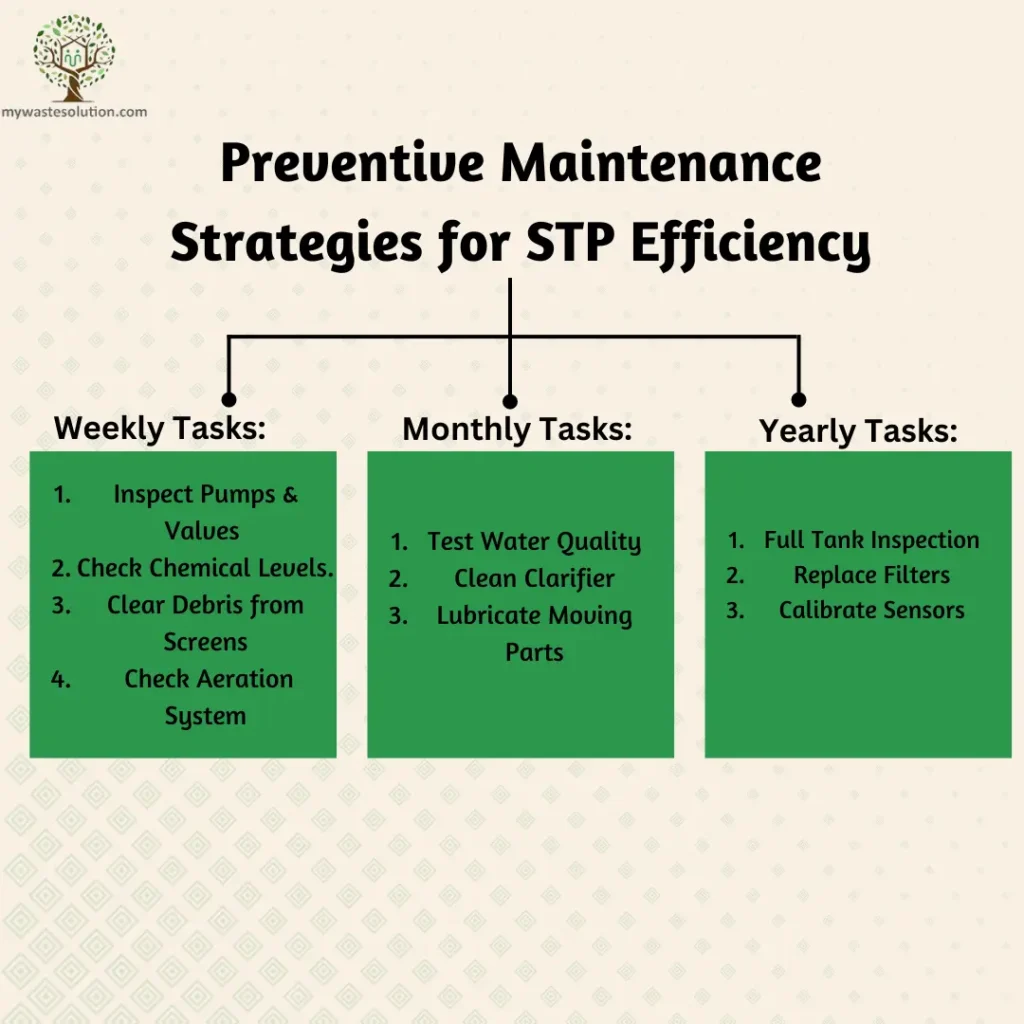
4.1 Regular Inspections for Efficiency
Chemical imbalances in sewage treatment plant maintenance can disrupt vital biological processes, reducing wastewater treatment effectiveness.
Fluctuations in chemical concentrations may lower microbial performance, impacting efficiency and potentially causing ecological damage.
A. Mitigation Strategies:
Monitoring Systems: Regular monitoring is essential for evaluating chemical concentrations.
Precise Dosing Mechanisms: These maintain optimal chemical equilibrium for effective wastewater treatment.
B. Proactive Adjustments:
Frequent adjustments based on monitoring data ensure microbial stability and enhance the purification process.
This proactive approach helps meet environmental regulations and protects natural water ecosystems, ensuring efficient wastewater treatment.
4.2 Scheduled Cleanings for STP Maintenance
Scheduled cleanings are vital to preventive maintenance in sewage treatment, targeting the removal of accumulated debris, solid waste, and other materials that hinder system efficiency.
Following a regular cleaning schedule helps prevent clogging and ensures the treatment process remains optimal by focusing on areas prone to buildup, such as pipes, screens, and filters, ensuring seamless wastewater flow.
A. Cleaning Procedures:
Maintenance teams thoroughly clean key components by removing sludge, sediment, and obstructions. Additionally, screens and filters are cleaned or replaced to ensure uninterrupted water flow.
B. Preventive Measures:
Beyond routine tasks, scheduled cleanings serve as an essential preventive measure. Regular cleaning and inspection enable the detection of potential blockages, allow adjustments to equipment settings, and ultimately enhance system resilience.

Explore the best sewage treatment plants for your industrial needs.
Connect Today5. How Maintenance Boosts STP Efficiency and Longevity
Understanding the effect of preventive maintenance on STP operations is essential not only for maximizing efficiency but also for extending durability. This section underscores how organized service procedures are crucial for achieving top performance while also lengthening the lifespan of our infrastructure. Routine care is more than a formality; it’s a strategic practice that ensures smooth operation as well as the long-term stability of our effluent management facility. By examining proactive service measures, we’ll illustrate how these efforts are indispensable for both maintaining a high-functioning and resilient processing plant.

5.1 Boosting Operational Efficiency:
In the complex realm of sewage processing, maintenance is vital for operational efficiency. Regular inspections act as essential health check-ups for our plant, helping us detect potential issues before they become major problems. Timely repairs, driven by these inspections, ensure smooth equipment operation, thereby reducing downtime and preserving treatment effectiveness.
Scheduled cleanings are another key aspect of our proactive strategy. By systematically removing debris, sludge, and obstructions, we enhance flow and prevent clogs, thus maintaining peak performance. These maintenance practices are crucial for boosting the efficiency and longevity of our sewage treatment plant, ensuring that it operates smoothly and achieves all operational goals.
5.2 Extending Plant Lifespan:
Our Sewage Treatment Plant is more than just infrastructure; it’s a critical system requiring ongoing attention. Maintenance is essential for maintaining its longevity and health, involving not just assessments but also preventive measures, timely part replacements, and adjustments to address wear and tear. This approach provides crucial support for facility effectiveness and durability.
Predictive monitoring is our proactive strategy, utilizing advanced systems to anticipate and prevent issues before they escalate. In this way, foresight helps maintain the integrity of crucial components, just as a well-planned wellness program supports optimal performance.
The impact of regular care on facility efficiency and longevity underscores our commitment. By conducting vigilant evaluations along with continuous improvements, we not only enhance the facility’s health but also ensure environmental compliance and reliability. This guarantees the facility’s effectiveness and dependability for years to come.
6. Tech Innovations in Sewage Treatment Plant
As servicing practices evolve, technological innovations are transforming wastewater management. This chapter explores how cutting-edge technology is reshaping service strategies, thereby ushering in a new era of efficiency and precision. Discover how the latest advancements enhance our ability to manage and maintain Sewage Treatment Plants, ultimately ensuring optimal performance and longevity. By reducing these innovations, facilities can stay ahead in maintaining operational excellence and environmental responsibility.
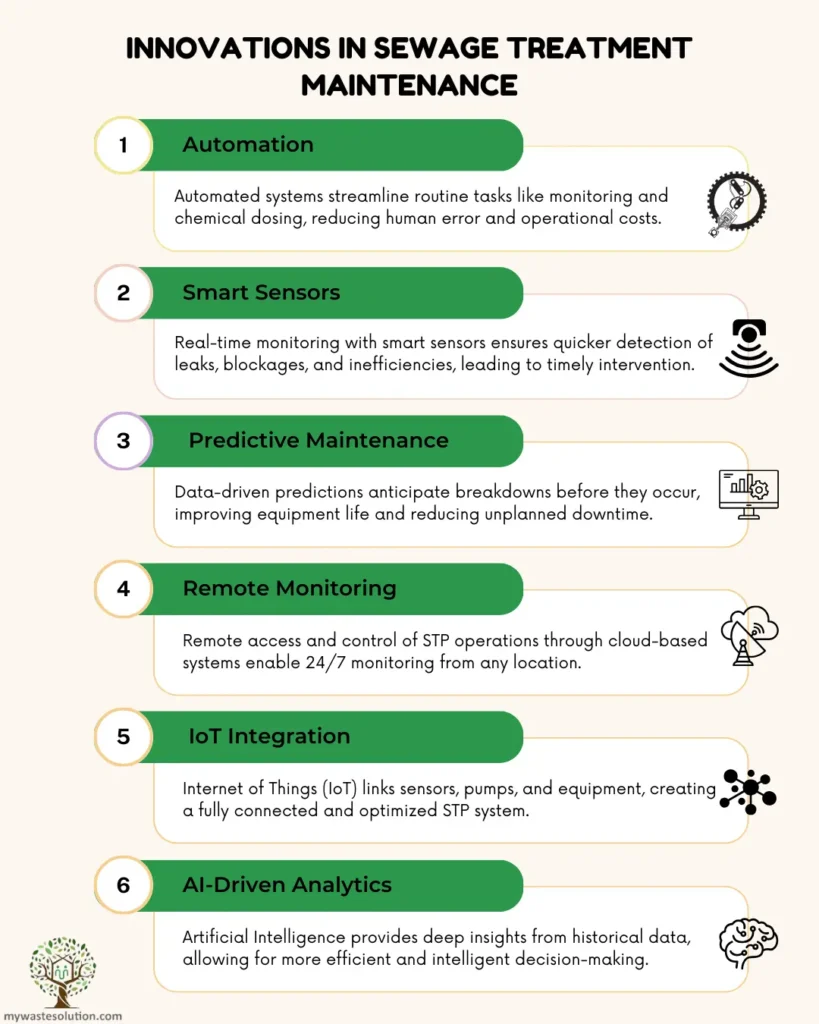
6.1 Predictive Maintenance for STPs
Advancements in sensors, data analytics, and machine learning have transformed predictive upkeep in wastewater processing facilities. Continuous monitoring of equipment status and performance metrics helps forecast potential issues before they develop. This proactive approach reduces downtime, enables prompt interventions, and prolongs the lifespan of essential components. Utilizing these technologies ensures optimal efficiency and dependability of water purification systems, ultimately contributing to smoother and more reliable operations.
6.2 Remote Monitoring and Control Systems
Remote monitoring and automation systems have significantly transformed sewage processing control operations. Real-time observation not only enables facility operators to manage and oversee processes from any location but also boosts efficiency while facilitating rapid responses to issues. The virtual configuration of settings and diagnostics provides enhanced oversight of management, which in turn enhances overall performance and dependability. As a result, this technological progress ensures the swift resolution of operational challenges, thus supporting a more efficient and streamlined sewage treatment plant maintenance process.
6.3 Internet of Things (IoT) Integration in Sewage Treatment
The integration of robotic technologies and drones in management represents a major advancement for Sewage Treatment Plant maintenance. To begin with, drones inspect hard-to-reach areas, providing high-resolution visual data for analysis, while at the same time, robotic systems perform complex tasks with high precision, thereby reducing manual intervention.
Additionally, these innovations enhance safety by minimizing human exposure to hazards and, as a result, accelerate servicing, improving operational efficiency. By adopting automation solutions and UAVs (Unmanned Aerial Vehicles), facilities can ensure swift, accurate issue resolution, ultimately boosting performance and reliability.
6.4 Robotics and Drones in Maintenance
The integration of robotic technologies and drones in management represents a major advancement for Sewage Treatment Plant maintenance. Drones inspect hard-to-reach areas, providing high-resolution visual data for analysis, while simultaneously, robotic systems perform complex tasks with high precision, reducing manual intervention.
These innovations enhance safety by minimizing human exposure to hazards, accelerate servicing, improving operational efficiency. By adopting automation solutions and UAVs (Unmanned Aerial Vehicles), facilities can ensure swift, accurate issue resolution, thus boosting performance and reliability.
6.5 Augmented Reality (AR) for Maintenance and Training
Augmented Reality is revolutionizing training and upkeep in Sewage Treatment Plants. For instance, AR applications deliver instantaneous information superimposed on machinery, thereby boosting troubleshooting and repair effectiveness. Consequently, this technology improves maintenance expertise while simplifying problem resolution.
In today’s technology-driven environment, innovations such as predictive analytics and live monitoring are enhancing operational performance, resilience, and sustainability in servicing practices. Discover how these advancements are reshaping the management of wastewater processing infrastructure.
7. Successful Sewage Treatment Plant Maintenance Case Studies
Rithala Sewage Treatment Plant in Rohini, Delhi:
Facing Delhi’s growing sewage management challenges, the Rithala Wastewater Control Facility is a leader in innovation and sustainability. As a result, effective effluent management is crucial for environmental protection and public health. In collaboration with the Delhi Jal Board, SUEZ, a leading provider of sewage treatment solutions, has developed this cutting-edge operation using cost-effective sewage treatment plant maintenance technology.
The site excels in pollutant conversion by using biogas engines to generate green power, which meets strict discharge standards and ensures regulatory compliance. SUEZ has also established five sewage treatment plants in Delhi, managing a total of 400 MLD of wastewater with operational excellence.
Kodungaiyur STP, Chennai:
The Kodungaiyur Sewage Treatment Plants are essential in managing Chennai’s vast sanitation needs. As the largest facility in the region, it efficiently handles 270 MLD of wastewater, serving a population of over 10 million. Specifically, the facility includes multiple processing units with capacities of 110 MLD, 80 MLD, and 80 MLD, designed to manage flows from Manali and Chinnasekkadu. Moreover, according to the Tamil Nadu government’s latest data, the Kodungaiyur site processes an impressive 230 MLD daily.
Operated by the Chennai Metropolitan Water Supply and Sewerage Board (Metro water), the facility is well-known for its outstanding upkeep practices, which ensure top-tier operational performance and play a critical role in the city’s sanitation infrastructure. The facility safeguards crucial resources and supports environmental health, including coastal ecosystems. This emphasizes the importance of effective upkeep in sustaining urban water systems.
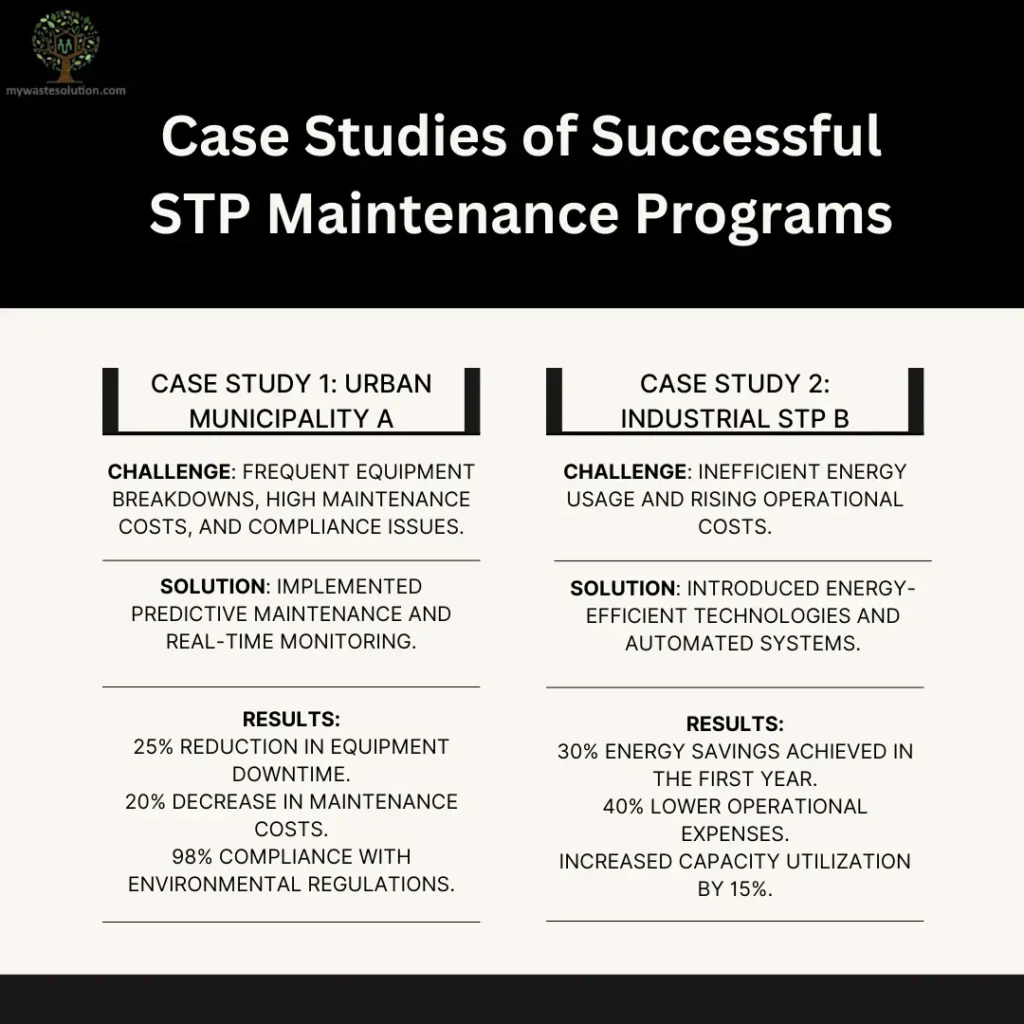
8. Regulatory Compliance & Safety in for Sewage Treatment Plant Maintenance
In Sewage Treatment Plant maintenance, adhering to regulatory guidelines and prioritizing protection protocols is critical. Meeting compliance with ecological standards is essential for responsible wastewater management, as it significantly reduces the facility’s environmental footprint. We integrate regulatory adherence and protection measures into maintenance practices, effectively minimizing negative impacts on nature, ensuring worker well-being, and reinforcing our commitment to secure wastewater operations. This forward-thinking strategy not only fulfills legal obligations but also promotes a culture of responsibility and ecological stewardship, assuring the community of our dedication to sustainable and safe operations.
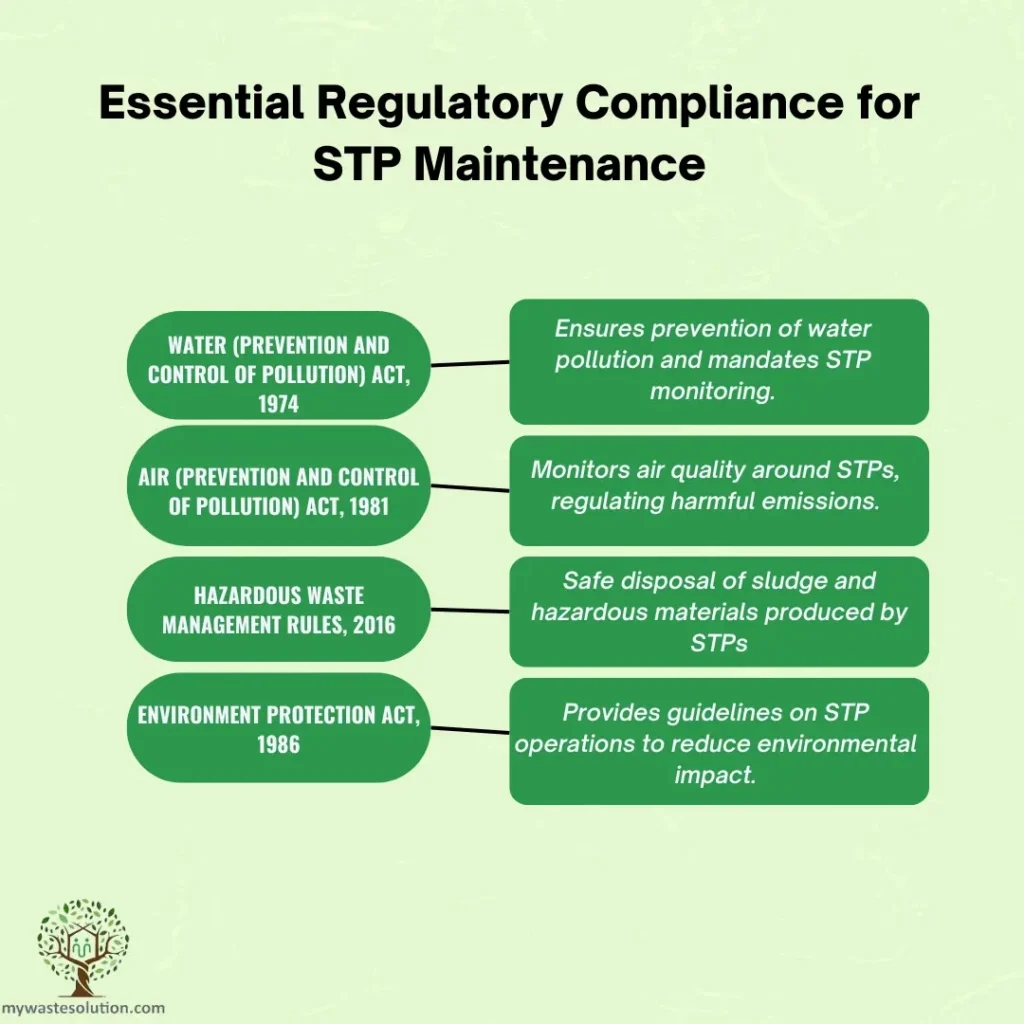
8.1 Environmental Regulations
Incorporating eco-friendly guidelines into STP maintenance is essential for sustainable wastewater management. Here’s a comprehensive breakdown of their significance:
- Discharge Standards: Set thresholds on the volume and quality of effluent released into water bodies. Regular maintenance ensures compliance, preventing ecological damage.
- Pollutant Control: Limits pollutants in treated wastewater to protect the environment. Routine servicing focuses on minimizing contaminants.
- Monitoring and Reporting: Continuous systems oversee effluent quality. Servicing teams document results for compliance and transparency.
- Efficiency Enhancement: Promotes advanced technologies for improved treatment performance. Regular Care integrates upgrades to meet eco-friendly benchmarks.
- Waste Disposal Protocols: Guidelines for sludge and by-product management. Maintenance ensures alignment to prevent environmental risks.
- Community Engagement: Emphasizes community involvement. Support includes efforts to engage and inform the local population.
- Adaptation to New Guidelines: As regulations change, management practices must evolve. Teams stay updated to ensure continuous compliance.
- Legal Ramifications: Non-compliance may result in fines or closures. Following guidelines avoids legal consequences and supports environmental stewardship.
Integrating eco standards into Sewage Treatment Plant Maintenance aligns with sustainability goals, safeguards ecosystems, and ensures effluent meets required standards.
8.2 Safety Protocols for Maintenance Workers
In the Sewage Treatment Plant maintenance process, worker protection is critical. Following stringent protocols is vital to safeguard personnel dealing with hazardous machinery and substances. Key protective measures include:
- Training Programs: Extensive training covers chemical handling, operating machinery, emergency response, and proper use of personal protective gear.
- Protective Gear: Required items such as gloves, masks, and goggles help shield workers from dangerous substances, ensuring physical well-being.
- Emergency Preparedness: Routine drills and established procedures for evacuation, first aid, and communication equip workers for unexpected incidents.
- Machinery Safety Protocols: Lockout/tagout practices and routine inspections help prevent unintentional startups and highlight risks.
- Chemical Handling Practices: Education on storage, disposal, and access to Material Safety Data Sheets (MSDS) promotes safe chemical use.
- Confined Space Entry: Permits and constant gas monitoring ensure safety when working in confined spaces.
- Communication Systems: Efficient channels and two-way radios allow rapid information flow and immediate coordination.
- Health Monitoring: Regular check-ups and early detection help maintain overall worker health.
- Mental Health Support: Access to counseling services offers mental well-being assistance for those handling operational stress.
- Continuous Training: Ongoing education and updates on protection protocols ensure adaptation to new technologies and evolving regulations.
Implementing these protective measures creates a secure environment, reducing risks and ensuring the health and safety of STP personnel.
9. Conclusion
It is clear that future breakthroughs, such as Artificial Intelligence (AI), drones, and augmented reality, are not only set to transform predictive maintenance but also revolutionize various industries. AI-driven machine learning will enable us to predict equipment failures, thereby minimizing downtime. The integration of sensors, robotics, and the Internet of Things (IoT) will not only enhance operational efficiency but also promote sustainability.
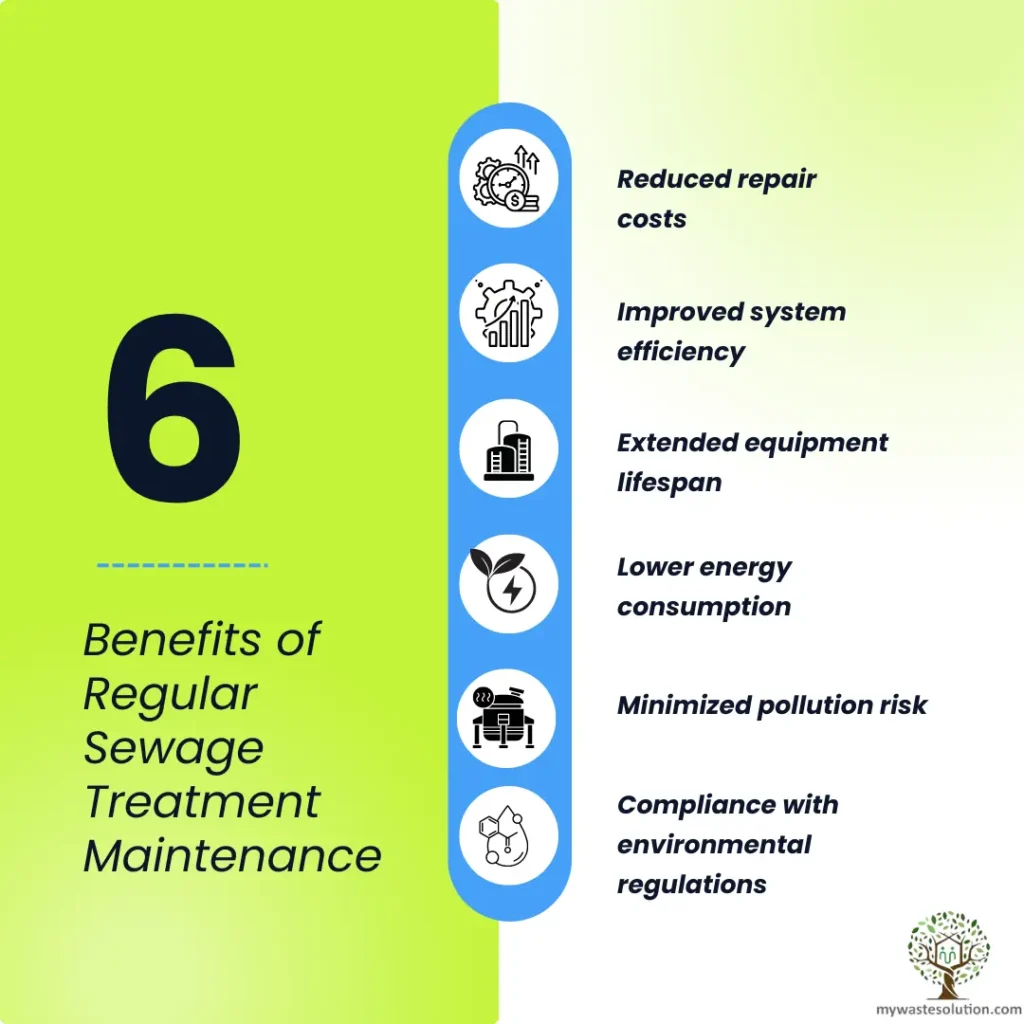
Ultimately, our overarching goal is to ensure cleaner air and pristine rivers. As we conclude, it’s important to appreciate the dedication of management professionals for making our cities and water systems healthier. Here’s to the future of sewage treatment plant maintenance, powered by innovation for a more efficient world.
